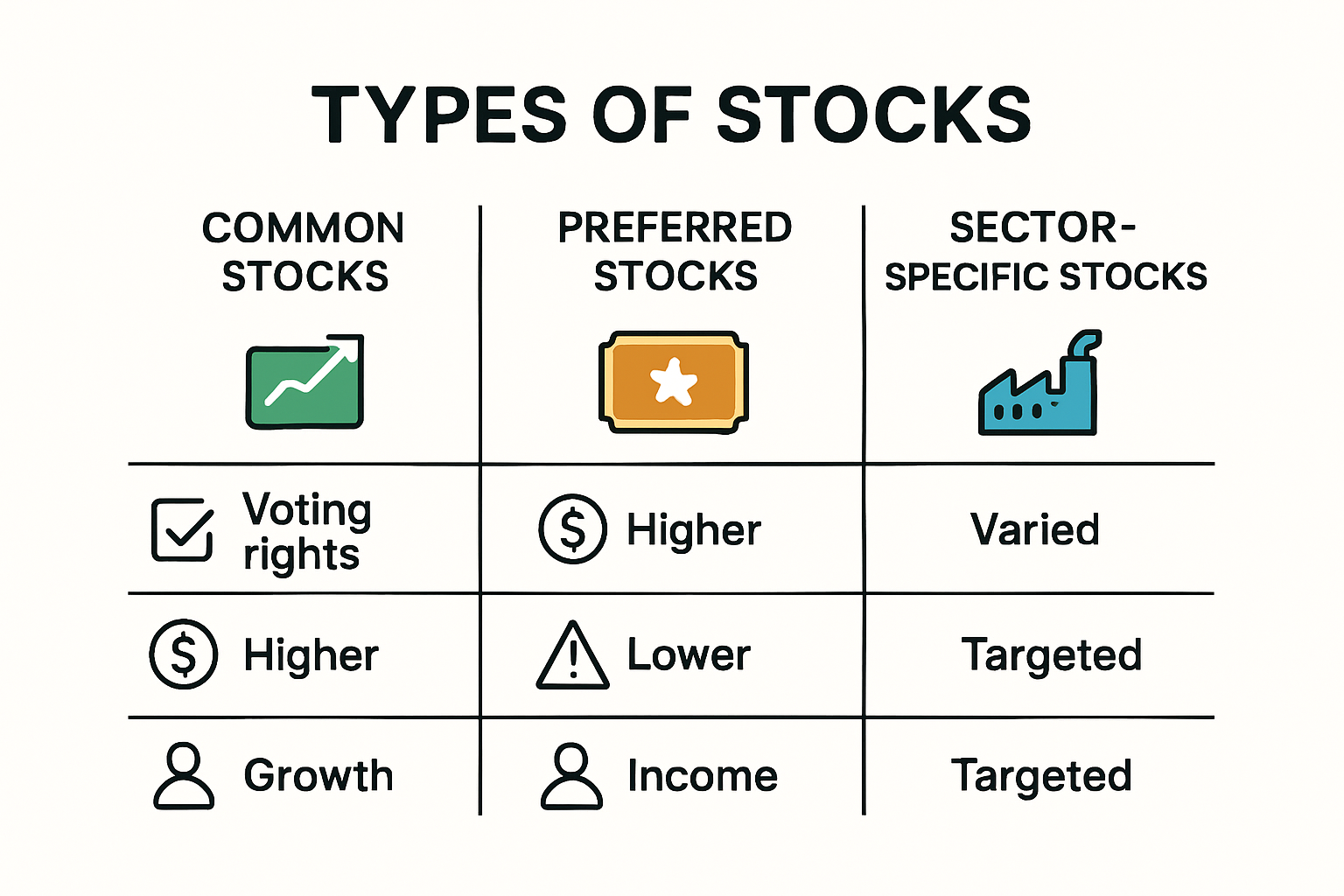Stocks are everywhere in conversations about money and the future. Most people have heard that the average annual return of the stock market is about 10 percent a year over the long term, far outpacing savings accounts. That sounds like easy wealth, right? The truth is stocks are not just numbers on a screen or lottery tickets for quick riches. They are actual pieces of real companies and play a bigger role in shaping your financial life than most people realize.
Table of Contents
- Understanding What A Stock Is
- Types Of Stocks And How They Differ
- How Stocks Are Bought And Sold
- Why Stocks Matter For Your Financial Goals
Quick Summary
| Takeaway | Explanation |
|---|---|
| Stocks are ownership pieces of companies | Buying stock means owning a fraction of a company, linking you to its success. |
| Common and preferred stocks serve different needs | Common stocks allow voting rights; preferred stocks provide fixed dividends without voting rights. |
| Understand stock market orders for effective trading | Familiarize yourself with market and limit orders to control buying and selling strategies. |
| Stocks are crucial for long-term wealth and inflation protection | Investing in stocks can generate returns over time and help maintain purchasing power against inflation. |
| Diversification reduces investment risk | Spread investments across various sectors to manage risk effectively and enhance financial resilience. |
Understanding What a Stock Is
Stocks represent more than just financial instruments they are fundamental pieces of ownership in the business world. When you purchase a stock, you are essentially buying a small slice of a company’s overall value and potential future success.
The Basic Definition of Stock
Corporate Finance Institute defines a stock as a type of security that represents fractional ownership in a corporation. Think of a stock like a piece of a puzzle where each share is a distinct segment representing a portion of the entire company. When you own stocks, you become a partial owner with certain rights and potential benefits.
Stocks are typically issued by publicly traded companies as a method to raise capital for business expansion, research and development, or other strategic initiatives. By selling shares, companies can generate funds without taking on debt, while investors gain an opportunity to participate in the company’s potential financial growth.
How Stocks Generate Value
Stocks can generate value for investors through two primary mechanisms: price appreciation and dividends. Price appreciation occurs when the market value of a stock increases over time, allowing investors to sell their shares at a higher price than their initial purchase. Dividends represent periodic cash payments made by some companies to their shareholders as a distribution of corporate profits.
The following table summarizes the two main ways stocks can generate value for investors, along with brief explanations.
| Value Generation Method | What It Means | How Investors Benefit |
|---|---|---|
| Price Appreciation | Stock’s market price increases over time | Sell at higher price than bought |
| Dividends | Company pays periodic cash to owners | Receive regular income |
Investopedia explains that stocks are traded on various exchanges like the New York Stock Exchange (NYSE) and NASDAQ, where their prices fluctuate based on multiple factors including company performance, market sentiment, economic conditions, and investor perceptions.
Types of Stocks
Investors can choose from different types of stocks, each offering unique characteristics. Common stocks provide voting rights in shareholder meetings and potential dividend payments. Preferred stocks typically offer fixed dividend payments but usually lack voting privileges. Some stocks represent specific sectors like technology, healthcare, or finance, allowing investors to strategically diversify their investment portfolios.
Understanding stocks requires recognizing them as dynamic financial instruments that connect individual investors with corporate growth opportunities. By comprehending their fundamental nature, investors can make more informed decisions about building wealth and participating in the broader economic ecosystem.
Types of Stocks and How They Differ
The stock market offers a diverse range of investment opportunities, with different types of stocks providing unique characteristics and potential benefits for investors. Understanding these variations can help you make more strategic investment decisions.
Common Stocks: The Standard Investment Vehicle
The U.S. Securities and Exchange Commission (SEC) highlights that common stocks represent the most typical form of stock ownership. These stocks provide shareholders with voting rights in corporate decisions, allowing investors to participate in company governance. When you own common stocks, you have the potential to benefit from the company’s growth through price appreciation and potential dividend payments.
Common stockholders are essentially partial owners of the company, with their investment directly tied to the company’s performance. This means their returns can be more volatile compared to other investment types. If the company performs well, common stock values can increase significantly. Conversely, if the company struggles, the stock price may decline.
Preferred Stocks: A More Stable Investment Option
Investor.gov explains that preferred stocks offer a different investment profile compared to common stocks. These stocks typically provide fixed dividend payments, making them more attractive to investors seeking consistent income. Unlike common stocks, preferred stockholders usually do not have voting rights in corporate meetings.
Preferred stocks are structured to provide more predictable returns. They have a higher claim on company assets and earnings, which means preferred stockholders receive dividend payments before common stockholders. In the event of company liquidation, preferred stockholders also have priority in receiving their investment back.
Here’s a comparison table outlining the key differences between common stocks and preferred stocks, helping investors understand their unique features at a glance.
| Feature | Common Stocks | Preferred Stocks |
|---|---|---|
| Voting Rights | Yes | Typically No |
| Dividend Payments | Variable/Not Guaranteed | Fixed/Guaranteed |
| Priority in Dividends | After preferred stockholders | Before common stockholders |
| Ownership in Company | Yes | Yes |
| Claim on Assets (in liquidation) | Lower priority | Higher priority |
| Risk/Volatility | Higher | Lower |
| Suitable For | Investors seeking growth & voting | Investors seeking stable income |
Specialized Stock Categories
Beyond common and preferred stocks, investors can explore additional stock categories that cater to specific investment strategies. Growth stocks represent companies expected to increase in value faster than the market average, typically reinvesting profits into expansion rather than paying dividends. Value stocks, in contrast, are considered undervalued and potentially poised for future growth.
Sector-specific stocks allow investors to target particular industries like technology, healthcare, energy, or finance. These stocks enable more focused investment strategies, allowing individuals to align their portfolios with specific economic sectors they believe will perform well.
The complexity of stock types demonstrates the dynamic nature of investment opportunities. By understanding the nuanced differences between stock categories, investors can craft more sophisticated and personalized investment approaches that align with their financial goals and risk tolerance.


How Stocks Are Bought and Sold
Purchasing and selling stocks involves understanding several key mechanisms and platforms that facilitate financial transactions in the modern investment landscape. Investors have multiple avenues to trade stocks, each with unique characteristics and requirements.
Opening a Brokerage Account
FINRA emphasizes that the first step in stock trading is establishing a brokerage account. These accounts serve as your gateway to financial markets, allowing you to execute trades, monitor investments, and manage your portfolio. Modern investors can choose between traditional full-service brokers who provide personalized investment advice and online discount brokers that offer lower-cost trading platforms.
When selecting a brokerage, consider factors like commission fees, investment research tools, minimum deposit requirements, and user interface. Some platforms specialize in mobile trading, while others provide comprehensive desktop experiences. The right broker depends on your investment strategy, trading frequency, and personal preferences.
Understanding Stock Market Orders
Investor.gov explains that stock trades are executed through different types of market orders. A market order instructs your broker to buy or sell a stock immediately at the current market price. This approach guarantees execution but doesn’t ensure a specific price, which can fluctuate during volatile market conditions.
Limit orders provide more precise control, allowing investors to specify the maximum price they’re willing to pay when buying or the minimum price they’ll accept when selling. These orders protect investors from unexpected price swings but might not execute if the stock doesn’t reach the specified price. Other specialized order types include stop orders and trailing stop orders, which can help manage risk and protect potential gains.
Below is a summary table detailing the common types of stock market orders, providing clarity on how they function for investors.
| Order Type | Description | Benefit | Drawback |
|---|---|---|---|
| Market Order | Buy or sell immediately at current market price | Fast execution | No price guarantee |
| Limit Order | Buy or sell at a specified price or better | Price control | May not execute if price not met |
| Stop Order | Trigger buy/sell when stock reaches trigger price | Automates risk management | May execute at unfavorable prices |
| Trailing Stop | Adjusts trigger price as stock price moves | Locks in gains/protects against declines | May trigger due to short-term swing |
Trading Platforms and Exchanges
Stock trades occur through organized exchanges like the New York Stock Exchange (NYSE) and NASDAQ. These platforms create structured environments where buyers and sellers can efficiently trade securities. Electronic trading has revolutionized stock transactions, enabling near-instantaneous trades from anywhere with an internet connection.
Modern investors can choose between traditional stock exchanges and emerging digital platforms that offer fractional share investing. This innovation allows individuals to purchase portions of expensive stocks, making investment more accessible to those with limited capital. Some platforms even provide additional features like automatic dividend reinvestment and real-time market analytics.
Successful stock trading requires continuous learning, understanding market dynamics, and developing a strategic approach tailored to your financial goals. By comprehending the mechanics of buying and selling stocks, investors can make more informed decisions and potentially optimize their investment returns.
Why Stocks Matter for Your Financial Goals
Stocks represent more than just financial instruments they are powerful tools for achieving long-term financial objectives. Understanding how stocks can contribute to your personal financial strategy is crucial for building wealth and securing your financial future.
Building Long-Term Wealth
Morningstar research demonstrates that stocks have consistently outperformed other investment vehicles over extended periods. Historically, stock market returns have averaged around 10% annually, significantly higher than traditional savings accounts or bonds. This potential for growth makes stocks an essential component of wealth-building strategies.
Investing in stocks allows individuals to participate in economic growth and corporate success. As companies expand and become more profitable, stock values can appreciate, providing investors with potential capital gains. This mechanism enables ordinary individuals to benefit from the economic achievements of successful businesses.
Protecting Against Inflation
Federal Reserve Economic Data indicates that inflation gradually erodes the purchasing power of money. Stocks offer a powerful hedge against this economic challenge. When companies increase their prices in response to inflationary pressures, their revenues and potentially their stock values can rise, helping investors maintain the real value of their investments.
Dividend-paying stocks provide an additional layer of financial protection. Many established companies consistently increase their dividend payments, offering investors a growing income stream that can outpace inflation. This approach allows investors to generate passive income while potentially preserving and growing their initial investment.
Diversification and Financial Flexibility
Stocks enable investors to diversify their financial portfolios across different sectors, geographies, and company sizes. By spreading investments, individuals can manage risk more effectively and create more resilient financial strategies. Some investors choose to invest in index funds or exchange-traded funds (ETFs) that provide instant diversification with a single investment.
Retirement planning represents another critical area where stocks play a significant role. Retirement accounts like 401(k)s and Individual Retirement Accounts (IRAs) often include stock-based investments as core components. These investment vehicles help individuals systematically build wealth over decades, leveraging the power of compound growth.
The strategic use of stocks can transform financial planning from a passive activity to an active wealth-building process. By understanding stocks’ potential and implementing thoughtful investment strategies, individuals can create more robust financial futures, generate potential income, and work towards long-term economic security.


Frequently Asked Questions
What is a stock?
Stocks are securities that represent fractional ownership in a corporation. When you buy a stock, you own a small part of that company and are entitled to its potential future success.
How do stocks generate value for investors?
Stocks generate value primarily through price appreciation and dividends. Price appreciation occurs when the stock’s market value increases, while dividends are periodic cash payments made to shareholders from the company’s profits.
What are the different types of stocks?
The main types of stocks are common stocks and preferred stocks. Common stocks provide voting rights and potential dividends, while preferred stocks offer fixed dividends and usually no voting rights. Additionally, there are specialized categories like growth stocks and value stocks that cater to different investment strategies.
How can stocks help protect against inflation?
Stocks can serve as a hedge against inflation as their values often rise when companies increase prices to cope with inflationary pressures. Additionally, dividend-paying stocks can offer increasing income, which may outpace inflation over time.
Turn Stock Market Knowledge into Confident Investment Decisions
Feeling uncertain after learning what stocks really mean for your finances? Understanding common and preferred stocks is an important first step, but knowing how to apply that knowledge is where many investors get stuck. Whether it’s choosing the right brokerage, building a diversified portfolio, or figuring out how to truly protect your money against inflation, these choices can feel overwhelming—and costly if you get them wrong.


Start transforming your stock market understanding into real financial growth today. Visit finblog.com to connect with expert advice tailored to your needs. Our easy-to-use forms give you a safe and effective way to request educational guides, personal consultations, or actionable investment strategies. Don’t let indecision hold you back while those with expert support move forward. Take charge of your investment future now at finblog.com.










